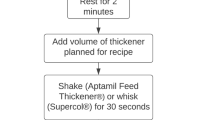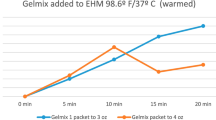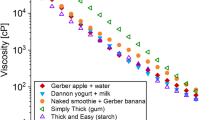Abstract
Infant dysphagia is commonly managed using thickened formulas. Substantial research investigates thickening of a variety of beverages for adults and children, yet few studies address the unique considerations of thickened formula for infants. Understanding the consistency and behaviour of thickened formula will guide clinicians and parents to make informed decisions to minimise risk of aspiration. To investigate the effect of time and storage temperature on the flow properties of thickened formula, four formulas and two thickeners currently utilised at a major metropolitan children’s hospital in Australia were tested in combinations, at refrigerated and room temperatures. Their flow properties were measured at three time-points (baseline, 1 h, 24 h) using the International Dysphagia Diet Standardisation Initiative (IDDSI) Flow Test, the current clinical standard for classifying drinks based on flow properties. A combination of paired t tests, Wilcoxon Signed-Rank tests, repeated measures analysis of variance (ANOVA) and Cohen’s d was used to statistically compare flow properties and determine the significance of the observed data. At baseline, 98% (n = 48) of the thickened formula bottles were measured as thinner than the “mildly thick” IDDSI category to which they were prepared. Conversely, at 24 h, 17% were measured thicker than “mildly thick” whilst 10% measured too thin for the category “mildly thick”. Refrigerated samples increased in thickness more significantly over time compared to those stored at room temperature. Two of the formulas, when thickened, resulted in a foamy mixture non-compatible with IDDSI Flow Test measurement. As a result, these two formulas were not subjected to further testing. All the tested commercial products behaved differently to each other and were unstable over varying times and temperatures. This finding indicates the need for improved guidelines regarding preparation and storage of thickened fluids. Further investigation is recommended into the chemical processes underlying the observed deviations.





Similar content being viewed by others
References
Motion S, Northstone K, Emond A, Stucke S, Golding J. Early feeding problems in children with cerebral palsy: weight and neurodevelopmental outcomes. Dev Med Child Neurol. 2002;44(1):40–3.
Peters T, Miles A, Jackson B. New Zealand speech-language therapists’ management of feeding in infants. Speech Lang Hear. 2019;22(4):215–26. https://doi.org/10.1080/2050571X.2019.1581451.
Cichero J, Nicholson TM, September C. Thickened milk for the management of feeding and swallowing issues in infants: a call for interdisciplinary professional guidelines. J Hum Lact. 2013;29(2):132–5. https://doi.org/10.1177/0890334413480561.
Gosa M, Schooling T, Coleman J. Thickened liquids as a treatment for children with dysphagia and associated adverse effects: a systematic review. ICAN Infant Child Adolesc Nutr. 2011;3(6):344–50. https://doi.org/10.1177/1941406411407664.
Hadde EK, Nicholson TM, Cichero JAY. Rheological characterisation of thickened fluids under different temperature, pH and fat contents. Nutr Food Sci. 2015;45(2):270–85. https://doi.org/10.1108/NFS-06-2014-0053.
Kim CY, Yoo B. Rheological characterization of thickened protein-based beverages under different food thickeners and setting times. J Texture Stud. 2018;49(3):293–9. https://doi.org/10.1111/jtxs.12332.
Yoon SN, Yoo B. Rheological behaviors of thickened infant formula prepared with Xanthan gum-based food thickeners for dysphagic infants. Dysphagia. 2017;32(3):454–62. https://doi.org/10.1007/s00455-017-9786-2.
Gosa MM, Dodrill P. Effect of time and temperature on thickened infant formula. Nutr Clin Pract. 2017;32(2):238–44. https://doi.org/10.1177/0884533616662991.
Almeida MB, Almeida JA, Moreira ME, Novak FR. Adequacy of human milk viscosity to respond to infants with dysphagia: experimental study. J Appl Oral Sci Rev FOB. 2011;19(6):554–9.
Dewar RJ, Joyce MJ. Time-dependent rheology of starch thickeners and the clinical implications for dysphagia therapy. Dysphagia. 2006;21(4):264–9. https://doi.org/10.1007/s00455-006-9050-7.
Garcia JM, Chambers Iv E, Matta Z, Clark M. Viscosity measurements of nectar- and honey-thick liquids: product, liquid, and time comparisons. Dysphagia. 2005;20(4):325–35. https://doi.org/10.1007/s00455-005-0034-9.
Garin N, De Pourcq JT, Martin-Venegas R, Cardona D, Gich I, Mangues MA. Viscosity differences between thickened beverages suitable for elderly patients with dysphagia. Dysphagia. 2014;29(4):483–8. https://doi.org/10.1007/s00455-014-9533-x.
Martínez O, Vicente MS, De Vega MC, Salmerón J. Sensory perception and flow properties of dysphagia thickening formulas with different composition. Food Hydrocoll. 2019;90:508–14. https://doi.org/10.1016/j.foodhyd.2018.12.045.
Cichero J, Nicholson T, Dodrill P. Liquid barium is not representative of infant formula: characterisation of rheological and material properties. Dysphagia. 2011;26(3):264–71. https://doi.org/10.1007/s00455-010-9303-3.
Frazier J, Chestnut AH, Jackson A, Barbon CEA, Steele CM, Pickler L. Understanding the viscosity of liquids used in infant dysphagia management. Dysphagia. 2016;31(5):672–9. https://doi.org/10.1007/s00455-016-9726-6.
Kulikov YM, Son EE. Fluid flow with abrupt viscosity-temperature dependence. High Temp. 2014;52(5):723–9. https://doi.org/10.1134/s0018151x14050216.
Smith CH, Jebson EM, Hanson B. Thickened fluids: investigation of users’ experiences and perceptions. Clin Nutr (Edinburgh, Scotland). 2013;33(1):171–4. https://doi.org/10.1016/j.clnu.2013.10.012.
Cichero J, Lam P, Steele CM, Hanson B, Chen J, Dantas RO, Duivestein J, Kayashita J, Lecko C, Murray J, Pillay M, Riquelme L, Stanschus S. Development of international terminology and definitions for texture-modified foods and thickened fluids used in dysphagia management: the IDDSI framework. Dysphagia. 2017;32(2):293–314. https://doi.org/10.1007/s00455-016-9758-y.
National Health and Medical Research Council. Literature Review: Infant Feeding Guidelines. Canberra: National Health and Medical Research Council; 2012.
Barbon CEA, Steele CM. Characterizing the flow of thickened barium and non-barium liquid recipes using the IDDSI flow test. Dysphagia. 2019;34(1):73–9. https://doi.org/10.1007/s00455-018-9915-6.
Hadde EK, Cichero JAY, Nicholson TM. Viscosity of thickened fluids that relate to the Australian National Standards. Int J Speech Lang Pathol. 2016;18(4):402–10. https://doi.org/10.3109/17549507.2015.1081289.
September C, Nicholson TM, Cichero JA. Implications of changing the amount of thickener in thickened infant formula for infants with dysphagia. Dysphagia. 2014;29(4):432–7. https://doi.org/10.1007/s00455-014-9523-z.
Steele CM, Alsanei WA, Ayanikalath S, Barbon CEA, Chen J, Cichero JAY, Coutts K, Dantas RO, Duivestein J, Giosa L, Hanson B, Lam P, Lecko C, Leigh C, Nagy A, Namasivayam AM, Nascimento WV, Odendaal I, Smith CH, Wang H. The influence of food texture and liquid consistency modification on swallowing physiology and function: a systematic review. Dysphagia. 2015;30(1):2–26. https://doi.org/10.1007/s00455-014-9578-x.
Sopade PA, Halley PJ, Cichero JAY, Ward LC, Hui LS, Teo KH. Rheological characterisation of food thickeners marketed in Australia in various media for the management of dysphagia. II. Milk as a dispersing medium. J Food Eng. 2008;84(4):553–62. https://doi.org/10.1016/j.jfoodeng.2007.06.024.
Payne C, Methven L, Fairfield C, Gosney M, Bell AE. Variability of starch-based thickened drinks for patients with dysphagia in the hospital setting. J Texture Stud. 2012;43(2):95–105. https://doi.org/10.1111/j.1745-4603.2011.00319.x.
Author information
Authors and Affiliations
Corresponding author
Ethics declarations
Conflict of interest
The study was conducted in conjunction with The Children’s Hospital at Westmead.
Additional information
Publisher's Note
Springer Nature remains neutral with regard to jurisdictional claims in published maps and institutional affiliations.
Rights and permissions
About this article
Cite this article
Ng, V., Bogaardt, H., Tzannes, G. et al. Thickened Formulas Used for Infants with Dysphagia: Influence of Time and Temperature. Dysphagia 37, 923–932 (2022). https://doi.org/10.1007/s00455-021-10353-w
Received:
Accepted:
Published:
Issue Date:
DOI: https://doi.org/10.1007/s00455-021-10353-w




